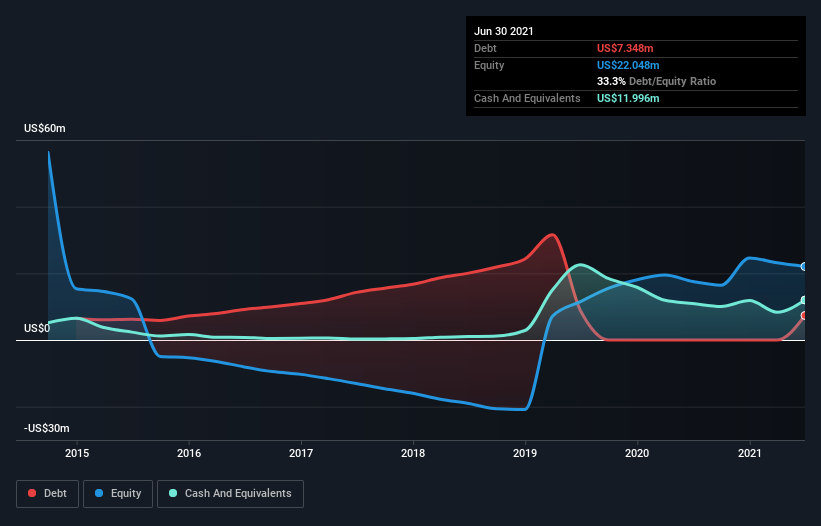Is CGX Energy (CVE:OYL) Using Too Much Debt?
Howard Marks put it nicely when he said that, rather than worrying about share price volatility, 'The possibility of permanent loss is the risk I worry about... and every practical investor I know worries about.' So it might be obvious that you need to consider debt, when you think about how risky any given stock is, because too much debt can sink a company. We note that CGX Energy Inc. (CVE:OYL) does have debt on its balance sheet. But is this debt a concern to shareholders?
Why Does Debt Bring Risk?
Generally speaking, debt only becomes a real problem when a company can't easily pay it off, either by raising capital or with its own cash flow. Ultimately, if the company can't fulfill its legal obligations to repay debt, shareholders could walk away with nothing. While that is not too common, we often do see indebted companies permanently diluting shareholders because lenders force them to raise capital at a distressed price. Of course, debt can be an important tool in businesses, particularly capital heavy businesses. The first thing to do when considering how much debt a business uses is to look at its cash and debt together.
See our latest analysis for CGX Energy
How Much Debt Does CGX Energy Carry?
As you can see below, at the end of June 2021, CGX Energy had US$7.35m of debt, up from none a year ago. Click the image for more detail. However, its balance sheet shows it holds US$12.0m in cash, so it actually has US$4.65m net cash.
A Look At CGX Energy's Liabilities
According to the balance sheet data, CGX Energy had liabilities of US$28.9m due within 12 months, but no longer term liabilities. On the other hand, it had cash of US$12.0m and US$556.6k worth of receivables due within a year. So it has liabilities totalling US$16.4m more than its cash and near-term receivables, combined.
Of course, CGX Energy has a market capitalization of US$458.0m, so these liabilities are probably manageable. But there are sufficient liabilities that we would certainly recommend shareholders continue to monitor the balance sheet, going forward. Despite its noteworthy liabilities, CGX Energy boasts net cash, so it's fair to say it does not have a heavy debt load! There's no doubt that we learn most about debt from the balance sheet. But it is CGX Energy's earnings that will influence how the balance sheet holds up in the future. So when considering debt, it's definitely worth looking at the earnings trend. Click here for an interactive snapshot.
Given its lack of meaningful operating revenue, CGX Energy shareholders no doubt hope it can fund itself until it can sell some combustibles.
So How Risky Is CGX Energy?
Statistically speaking companies that lose money are riskier than those that make money. And the fact is that over the last twelve months CGX Energy lost money at the earnings before interest and tax (EBIT) line. Indeed, in that time it burnt through US$12m of cash and made a loss of US$6.2m. With only US$4.65m on the balance sheet, it would appear that its going to need to raise capital again soon. Overall, we'd say the stock is a bit risky, and we're usually very cautious until we see positive free cash flow. There's no doubt that we learn most about debt from the balance sheet. But ultimately, every company can contain risks that exist outside of the balance sheet. For example, we've discovered 3 warning signs for CGX Energy (1 is a bit unpleasant!) that you should be aware of before investing here.
At the end of the day, it's often better to focus on companies that are free from net debt. You can access our special list of such companies (all with a track record of profit growth). It's free.
This article by Simply Wall St is general in nature. We provide commentary based on historical data and analyst forecasts only using an unbiased methodology and our articles are not intended to be financial advice. It does not constitute a recommendation to buy or sell any stock, and does not take account of your objectives, or your financial situation. We aim to bring you long-term focused analysis driven by fundamental data. Note that our analysis may not factor in the latest price-sensitive company announcements or qualitative material. Simply Wall St has no position in any stocks mentioned.
Have feedback on this article? Concerned about the content? Get in touch with us directly. Alternatively, email editorial-team (at) simplywallst.com.

 Yahoo Finance
Yahoo Finance 
